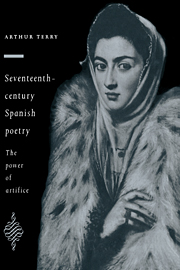Book contents
- Frontmatter
- Contents
- Preface
- List of abbreviations
- 1 The inheritance
- 2 Theory and practice
- 3 Luis de Góngora: the poetry of transformation
- 4 Lope de Vega: re-writing a life
- 5 Between two centuries: from Medrano to Valdivielso
- 6 Francisco de Quevedo: the force of eloquence
- 7 The literary epic
- 8 Plenitude and decline: from Villamediana to the second half of the century
- 9 Sor Juana Inés de la Cruz: the end of a tradition
- Epilogue
- Notes
- Select bibliography
- Index
8 - Plenitude and decline: from Villamediana to the second half of the century
Published online by Cambridge University Press: 01 October 2009
- Frontmatter
- Contents
- Preface
- List of abbreviations
- 1 The inheritance
- 2 Theory and practice
- 3 Luis de Góngora: the poetry of transformation
- 4 Lope de Vega: re-writing a life
- 5 Between two centuries: from Medrano to Valdivielso
- 6 Francisco de Quevedo: the force of eloquence
- 7 The literary epic
- 8 Plenitude and decline: from Villamediana to the second half of the century
- 9 Sor Juana Inés de la Cruz: the end of a tradition
- Epilogue
- Notes
- Select bibliography
- Index
Summary
To move back from the literary epic to the shorter verse forms is to become aware, once again, of the immense amount of poetic activity going on in what seems at first sight a situation of quite bewildering complexity. One fact, however, stands out: where most of the poets I discussed in chapter 5 achieved their characteristic styles in the first decade of the seventeenth century or even earlier, the ones I now want to consider nearly all produced their best work in the half century or so following the appearance of Góngora's major poems, the Polifemo and the Soledades, in 1612–13. Whatever other factors come into play, this, clearly, is the great stylistic divide: from this point on, the example of Góngora, however much resisted in some quarters, becomes inescapable, and leaves its mark on a great deal of later poetry, both good and bad, until well into the eighteenth century. At the same time, as we shall see, other forces are at work: various regional groupings and affinities, the persistence of the literary academies, the new role of the court as patron of the arts and – more nebulous, though no less real – the growing sense of national crisis which is felt at every level of society, and which is inevitably reflected in the poetry of the time.
One sign of change, as I have already mentioned (see above, p. 140), is the appearance of a new kind of courtier poet, most notably represented by the Conde de Salinas and his slightly later successors, the Conde de Villamediana (1582–1622) and Antonio Hurtado de Mendoza (1586–1644).
- Type
- Chapter
- Information
- Seventeenth-Century Spanish Poetry , pp. 208 - 237Publisher: Cambridge University PressPrint publication year: 1993



